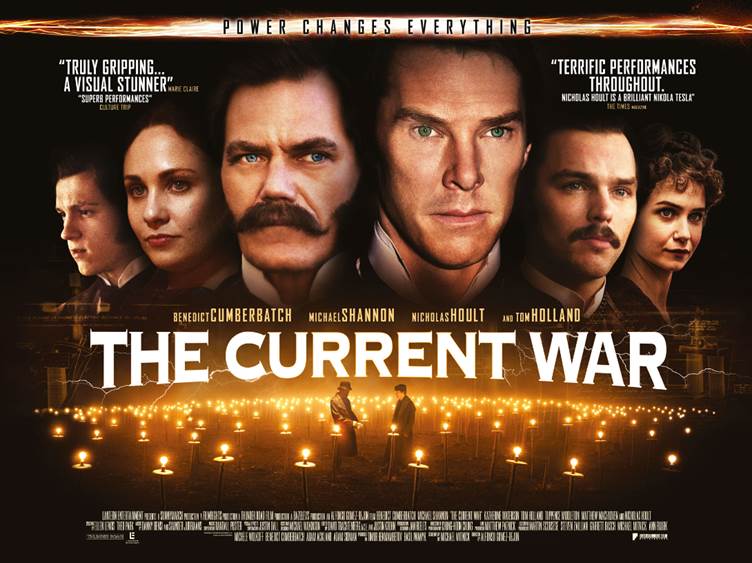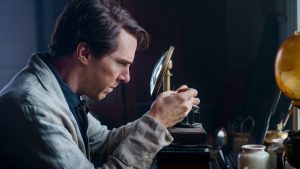
Thomas Edison (Benedict Cumberbatch) and George Westinghouse (Michael Shannon) enter into a bitter rivalry over whose electrical system will power the future. But while AC fights DC, an unexpected visionary from Serbia named Nikola Tesla (Nicholas Hoult) has his own ideas, and the potential to use electricity as a means of execution looms over the competing inventors.
Before discussing the interesting piece of history that this film exhibits, it is perhaps equally as interesting to highlight the troubled history of the production itself. If viewers are wondering why Tom Holland (who plays Edison’s assistant Samuel Insull) looks and sounds a bit younger than he did for this year’s Spider-Man: Far From Home, it is because this film was shot in 2016, and already saw its premiere at the Toronto International Film Festival in 2017. The reason why it’s only seeing a UK release in mid-2019 is of no thanks to the film’s originally intended distributer – The Weinstein Company.
According to director Alfonso Gomez-Rejon, Harvey Weinstein had pressured him to get the film finished and edited in time for the festival, an edit that Gomez-Rejon greatly disliked. Only some weeks later, the allegations against Weinstein led to the company’s eventual dissolution, and the film was shelved for two years, during which Gomez-Rejon supposedly added five additional scenes and cut 10 minutes from its runtime. The result of all this is that we as an audience will never fully know how this led to the product that’s now in cinemas: is this representative of the director’s initial intent before Weinstein interfered? A Frankenstein’s monster of an edit cobbled together by an initially rushed post-production? Is it a mix of both? Fascinatingly, the film could either be one of these things or all of them.
Quite cleverly, the film starts with bright, purely white light before revealing Cumberbatch’s Edison standing in what seems to be a blizzard or snow of some kind. Immediately, it inspires comparison to the stark white light of electricity and its commodification brought about by the result of the subsequent ‘War of the Currents’ that we will soon be watching. It’s not immediately clear where Edison is, nor why he is there, or even where in the narrative this takes place. However, once this is eventually revealed by the film’s end, it is able to make some clever visual commentary on the legacy of this story in relation to the medium in which we are experiencing it. It is cinematic flourishes such as this that make Gomez-Rejon’s artistic intent evident.

Benedict Cumberbatch plays Thomas Edison in The Current War
There are, however, aspects of the film that surely couldn’t have been the results of troubled post-production, but instead some questionable and divisive filmmaking decisions. Gomez-Rejon and cinematographer Chung-hoon Chung opt to essentially distort the image of nearly every frame: wide-angle lenses curl actors at the corners, Dutch angles tip scenes for seemingly no reason, and claustrophobic camera placements act to make scenes feel uncomfortably intimate with mixed results. Digital whip pans make simple geographical traversal feel needlessly nauseating at times, and attempts at long takes wherein the camera bobs and weaves without cutting show up repeatedly in the first act, then disappear in the following acts. Flashback sequences with overblown lighting confuse the narrative until eventually being explained towards the end, but the actual reasoning and emotional result of them is dubious. I found myself unsure of how to assess it – on the one hand, it was interesting to see a historical drama try for a more dynamic way to tell the story, on the other, it could feel a little superfluous.
The story the film is telling, however, is fascinating. While Cumberbatch is trying really, really hard to play against type as a narcissistic genius, Shannon brings what I can only describe as a stern warmth to Westinghouse, a presence that immediately sells both how and why his character is so influential in the film’s historical world, and his consistency in being so makes his rivalry with an increasingly spiteful Edison more interesting to watch. The film does a great job of making you flip back and forth between allegiance with either of the two, their positive and negative traits displayed in equal measure through their social interactions and shared determination to prove why they are right in their beliefs. The supporting cast is excellent also, in particular Katherine Waterston as Westinghouse’s strong-willed, tenaciously business-minded wife Margaret, and Hoult’s Tesla, who is given a roguish spark of endearing charm.
Less successful however is how the narrative jerks quite recklessly between some of the leads’ conflicts, notably stumbling in presenting how the introduction of the electric chair was such an important aspect of this tale. What should be key to the narrative instead feels like a distraction from the intriguing rivalry between three different men with the same goal. Perhaps that aspect could be attributed to the initially botched edit and, with a clear vision from the start, this could have incorporated more satisfyingly.
Neither as bad as some critics are saying nor as good as it perhaps could have been, The Current War is equal parts engaging and haphazard. I am glad it finally saw the light of day, but it’s hard to ignore the feeling that it hasn’t quite escaped the dark.

Author: Tom, Prestwich Store





